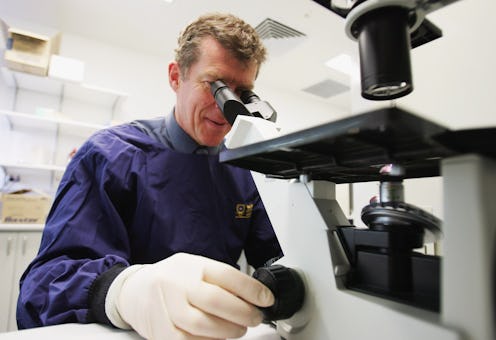Wellness
Australia Is On Track To Eradicate Cervical Cancer In The Next 20 Years, Thanks To This Vaccine

A new report published this week suggests that Australia is on track to eradicate cervical cancer, with diagnosis predicted to drop to nearly zero in the next 20 years. The report, published in the The Lancet suggests that a coordinated attack on the human papilloma virus or HPV, the virus that causes cervical cancer in people with cervixes. Since the 1990s, Australia has implemented rigorous testing for HPV, and in 2007, the country introduced compulsory HPV vaccines for all schoolchildren. (As an Australian myself, I was part of this first wave of vaccinations.)
According to the World Health Organization, cervical cancer is the fourth most common cancer in women worldwide, and 270,000 women died of it in 2012. The National Cancer Institute notes that "virtually all" cervical cancers are caused by the spread of HPV, and that two particular strains of HPV, 16 and 18, are linked to nearly three-quarters of all diagnoses. Australia has used two HPV vaccines since 2007: Gardasil, which protects against four HPV types, and Gardasil 9, which protects against nine types that cause over 90 percent of cervical cancers.
When the compulsory vaccinations came into law in 2007, I was 19, and part of the first target demographic for the vaccinations: girls between 12 and 26. The vaccinations were free for all women in that age group between 2007 and 2009. As part of a family of doctors with a history of uterine cancers, I lined up and had my two Gardasil shots as quickly as possible. A third of women in the age group had their shots in that period, according to national statistics, and now up to 80 percent of all Australian teenage girls have had their HPV vaccinations.
In my teens and 20s, it was standard to be given a Pap smear for HPV and other illnesses every two years. The Pap has been replaced in Australia in 2017 by the Cervical Screening Exam, which focuses specifically on HPV and is efficient enough to only be necessary every five years. It's anticipated to drive cases down by another 20 percent, The Guardian reports.
The idea of mandatory or heavily encouraged vaccinations for HPV and frequent screenings wasn't exactly palatable to everybody, though. I remember the controversy on the opinion pages of every newspaper. HPV vaccinations, opponents claimed, might encourage girls and boys to have sex rather than maintaining abstinence till marriage. (HPV is primarily transmitted through sexual contact.)
This argument, while unfounded, may be familiar for people who saw Gardasil roll out in the United States, though it was not adopted to the same degree. A study in the American Medical Association Journal of Ethics in 2012 noted that in America, "vaccine coverage is hindered by public perceptions regarding HPV’s status as a sexually transmitted infection and dissent over the recommended age of vaccination." The authors noted that in the United States, where HPV vaccinations aren't compulsory, people hesitate to get them for their kids because they're worried about promiscuity and aren't properly informed about the vaccine's safety. The Center of Disease Control notes that in 2017, only 48.6 percent of American teens had both of their HPV vaccinations, and a 2018 study said that 14 million additional teens need to get their vaccinations to reach the government's public health goals.
Both Gardasil 9 and the Cervical Screening Exam are new frontiers in the fight against HPV-related cancers, though there's still a need for more work: even Gardasil-9 doesn't protect women of color enough, for one thing. But alongside the need for more research, there also needs to be more public conversation about HPV, Gardasil, screenings and cervical cancers. That's the only way to bust myths — and save lives.